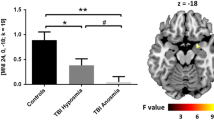Abstract
Olfactory loss is considered as idiopathic (IOL) when no cause can be found, neither on the basis of a standardized history nor a thorough clinical evaluation. Olfactory bulb volume (OB) has been shown to be decreased in patients with olfactory loss due to trauma, infections, or sinonasal disease. However, OB volume has not yet been investigated in IOL patients. Twenty-two patients with IOL were compared with 22 controls in terms of olfactory performance and of OB volume assessed with magnetic resonance imaging (MRI). Psychophysical testing confirmed that patients had lower scores than controls: P < 0.001 for threshold (T), discrimination (D), identification (I) and global TDI score. Mean right, left and total OB volumes were significantly smaller for IOL patients as compared to controls. Both for IOL and controls, there was a significant correlation between odor thresholds and total OB volume, respectively. In conclusion, patients with IOL have decreased olfactory function and decreased OB volume when compared with controls. This was previously demonstrated for patients with postinfectious or posttraumatic olfactory dysfunction, but not for patients with uneventful conditions possibly damaging their olfactory apparatus.



Similar content being viewed by others
References
Mueller A, Rodewald A, Reden J, Gerber J, von Kummer R, Hummel T (2005) Reduced olfactory bulb volume in post-traumatic and post-infectious olfactory dysfunction. Neuroreport 16(5):475–478
Rombaux Ph, Mouraux A, Bertrand B, Nicolas G, Duprez T, Hummel T (2006) Olfactory function and olfactory bulb volume in patients with postinfectious olfactory loss. Laryngoscope 116:436–439
Ph Rombaux, Mouraux A, Bertrand B, Nicolas G, Duprez T, Hummel T (2006) Retronasal and orthonasal olfactory function in relation to olfactory bulb volume in patients with posttraumatic loss of smell. Laryngoscope 116:901–905
Goektas O, Fleiner F, Sedlmaier B, Bauknecht C (2010) Correlation of olfactory dysfunction of different etiologies in MRI and comparison with subjective and objective olfactometry. Eur J Radiol
Abolmaali ND, Gudziol V, Hummel T (2008) Pathology of the olfactory nerve. Neuroimag Clin N Am 18:233–242
Rombaux Ph, Potier H, Bertrand B, Duprez T, Hummel T (2008) Olfactory bulb volume in patients with sinonasal disease. Am J Rhinol 22(6):598–601
Youssem DM, Geckle RJ, Doty RL, Bilker WB (1997) Reproducibility and reliability of volumetric measurements of olfactory eloquent structures. Acad Radiol 4(4):264–269
Buschhüter D, Smitka M, Psuchmann S, Gerber JC, Witt M, Abolmaali ND, Hummel T (2008) Correlation between olfactory bulb volume and olfactory function. Neuroimage 42(2):498–502
Rombaux Ph, Mouraux A, Bertrand B, Duprez T, Hummel T (2007) Can we smell without an olfactory bulb? Am J Rhinol 21(5):548–550
Mori K, Nagao H, Yoshihara Y (1999) The olfactory bulb: coding and processing of odor molecule information. Science 286:711–715
Curtis MA, Kam M, Nanmark U et al (2007) Human neuroblasts migrate to the olfactory bulb via a lateral ventricular extension. Science 315(5861):1243–1249
Gomez C, Brinon JG, Colado MI, Orio L, Vidal M, Barbado M, Alonso J (2006) Differential effects of unilateral olfactory deprivation on noradrenergic and cholinergic systems in the main olfactory bulb of the rat. Neuroscience 141:2117–2128
Mueller A, Abolmaali ND, Hakini AR et al (2005) Olfactory bulb volume in patients with idiopathic Parkinson’s disease—a pilot study. J Neural Transm 112:1363–1370
Kim JY, Lee WY, Chung EJ, Dhong HJ (2007) Analysis of olfactory function and the depth of olfactory sulcus in patients with Parkinson’s disease. Mov Disord 22(11):1563–1566
Kobal G, Klimek L, Wolfensberger M, Gudziol H, Temmel A, Owen CM et al (2000) Multicenter investigation of 1, 036 subjects using a standardized method for the assessment of olfactory function combining tests of odor identification, odor discrimination and olfactory thresholds. Eur Arch Otorhinolaryngol 257:205–211
Heilmann S, Strehle G, Rosenheim K, Damm M, Hummel T (2002) Clinical assessment of retronasal olfactory function. Arch Otolaryngol Head Neck Surg 128(4):414–418
Keppel G (1991) Design and analysis: a researcher’s handbook. Prentice Hall, Upper Saddle River
Negoias S, Croy I, Gerber J, Joraschky P, Hummel T (2009) Reduced olfactory bulb volume and olfactory sensitivity in patients with acute major depression. Proceedings of the Deutsche ArGe Olkaktologie/Gustologie Dec 2009. http://www.tu-dresden.de/medkhno/riechen
Heilmann S, Huettenbrink KB, Hummel T (2004) Local and systemic administration of corticosteroids in the treatment of olfactory loss. Am J Rhinol 18:29–33
Haehner A, Hummel T, Hummel C, Sommer U, Junghanns S, Reichmann H (2007) Olfactory loss may be a first sign of idiopathic Parkinsons’s disease. Mov Disord 22:839–842
Ponsen MM, Stoffers D, Twisk JW, Wolters EC, Berendse HW (2009) Hyposmia and executive dysfunction as predictors of future Parkinson’s disease: a prospective study. Mov Disord
Koss E, Weiffenbach JM, Haxby JV, Friedland RP (1988) Olfactory detection and identification performance are dissociated in early Alzheimer’s disease. Neurology 38:1228–1232
Acknowledgments
The authors have no conflict of interest regarding this study.
Author information
Authors and Affiliations
Corresponding author
Rights and permissions
About this article
Cite this article
Rombaux, P., Potier, H., Markessis, E. et al. Olfactory bulb volume and depth of olfactory sulcus in patients with idiopathic olfactory loss. Eur Arch Otorhinolaryngol 267, 1551–1556 (2010). https://doi.org/10.1007/s00405-010-1230-2
Received:
Accepted:
Published:
Issue Date:
DOI: https://doi.org/10.1007/s00405-010-1230-2




